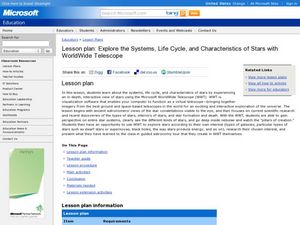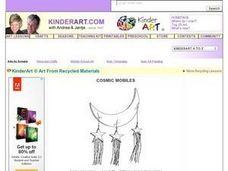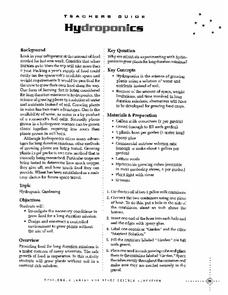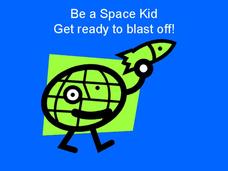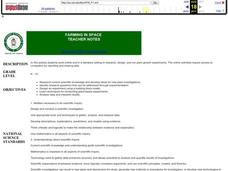Curated OER
Explore the Characteristics of Stars with Microsoft WorldWide Telescope
Young scholars explore the characteristics of stars. In this space science activity, students use the Microsoft WorldWide Telescope program to identify the properties of stars and identify the stars in the galaxy.
Alabama Learning Exchange
Far Out Food and Work in Space
Students discuss aspects of living and working in space as astronauts, as well as other careers in space science. They demonstrate their understanding of the food guide pyramid by designing a healthy food tray for an astronaut.
Curated OER
The Science of Sleep and Daily Rhythms: Sleeping in Space
Students write about strange places that they have slept. In this sleep science lesson students read about astronauts sleeping experience in space. They reflect on unusual places that they have slept and write about it.
Curated OER
Cosmic Mobiles: Recycled Art
If you have a little left over tinsel and aluminum foil, your class can create these fun moon and star mobiles. Poster board or recycled cardboard become your moon and stars; the tinsel gives them sparkle. This would be a great activity...
Tech Museum of Innovation
Balloon Astronaut
Design protection from high-speed particles. The STEM lesson plan highlights why astronauts need protection from space debris. Pupils use the design process to design, build, and test a spacesuit that will protect a balloon from a...
A to Z Teacher Stuff
Solar System Book
Young astronomers travel through the solar system in the pages of this printable book. With clear pictures and simple sentence structure, this is a perfect resource for exploring the planets in the early elementary grade levels.
Curated OER
Using a Graphic Organizer to Research a Question
Is Pluto still a planet? Using this popular question, kids are introduced to graphic organizers as a writing tool. As a class, they watch a demonstration on how to use them and work together with a partner to research whether Pluto is a...
Classroom Kit
Homes
Where do birds? What about frogs? Learn about animal habitats with a series of worksheets. Each page is divided into quarters and shows an animal, a sentence about where the animal lives, and a blank space to draw their homes.
Curated OER
Hydroponics
Students experiment with growing food using hyrdroponics. For this science lesson, students grow lettuce in a confined space with weight limitations. Students start a plastic pop bottle garden observing the growth and charting it....
Curated OER
Space Kids...Get Ready to Blast Off!
Be a space kid and learn about the moon. This simplistic presentation provides basic information on the location and surface of the moon, and appears to be learner generated. Tip: Have your class learn about the climate and surface of...
Curated OER
Embrace Space
Students use the internet to gather informatino about the solar system and space. In groups, they create a slideshow in which they use illustrations from the internet and include their own text. They complete the instructional activity...
Curated OER
How Hot and How Big?
Students explore star color and size. For this space science lesson, students conduct various inquiry activities to explore how the color of a star affects the amount of heat produced. They also investigate how the color of stars affects...
Curated OER
Farming in Space
Students research, design, and run plant growth experiments online. They explore websites, design an experiment using an animation-based building block program, construct a soda bottle hydroponic production unit and a cardboard plant...
Curated OER
Space Travel Writing Paper
In this space travel writing paper, students color the detailed border of stars, space shuttle, planets and astronauts. Students use the blank lines for creative or report writing.
Curated OER
Soaring in the Solar System
Who doesn't love learning about space? This presentation provides a mnemonic device and a song to help young students remember the names and basic facts about each of the nine planets in our solar system.
Coloring Castle
Planets
From Mercury to Uranus, this printable coloring page includes images of all eight planets found in our solar system, making it a fun way to engage young scientists in learning about outer space.
Desert Discoveries
What's In A Habitat?
The concept of a habitat being a home for animals is the main thrust of this life sciences resource. Learners complete a cut-and-paste activity using a fine worksheet that's embedded in the plan. They must place four very different...
Baylor College
There's Something in the Air
Clever! In order to compare indoor and outdoor dispersal rates for the movement of gases and particles through air, collaborators will participate in a classroom experiment. Set up a circular grid and set students on lines that are...
Curated OER
The Earth and Moon
An outstanding space science PowerPoint is here for your charges. It provides an effective overview of the Solar System; specifically the Earth and the Moon. The slides contain illustrations of the planets and focus on the Earth's...
Have Fun Teaching
Scientific Method
Encourage your students' inner scientist by conducting experiments and recording their findings. This printable incorporates every part of the scientific method into an easy-to-read outline of experimental questions, research,...
Curated OER
Make a Spaceship
Learners create a spaceship, satellite, or space station. In this space instructional activity, students consider design elements for buildings and objects in space. Learners use K'Nex, Legos, or other household materials for their...
Curated OER
Twinkle, Twinkle, Little Star
Students identify patterns in the stars. In this constellation lesson, students simulate constellations using black canisters and patterns. Students discuss the points on the constellations and how to draw imaginary lines to see the...
Curated OER
Cloud Watching
Young scholars analyze art as a cloud pattern activity. In this cloud and art instructional activity, students view April Gornik's painting The Back of the Storm and make connections between science and art. Young scholars observe cloud...
Curated OER
Making a Pinhole Camera
Students are introduced to the basic straight line pattern of travel that light takes. A cereal box and wax paper provide the pinhole camera that captures the light's inverted image. Shifting this pattern provides additional challenges.
Other popular searches
- Space Science
- Astronomy and Space Science
- Physical Science Space
- Earth and Space Science
- Science Space Experiment
- Space Science Vocabulary
- Science Space Lessons
- Space Science Astronomy
- Science Space Race
- Star Maps Science Space
- Earth Space Science
- Science Space Station


